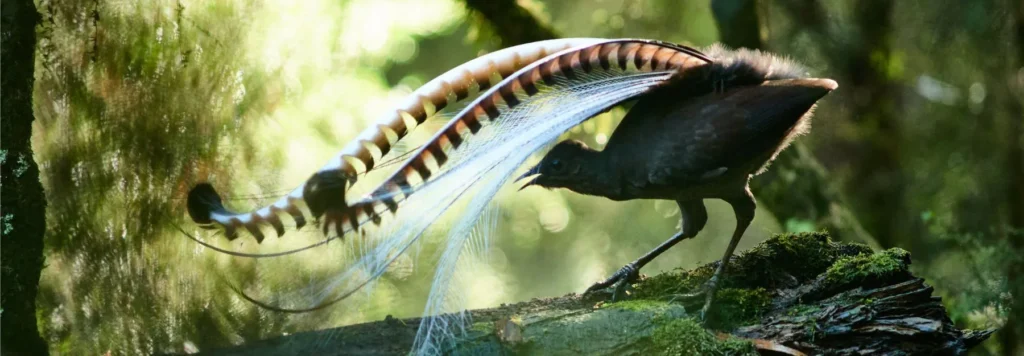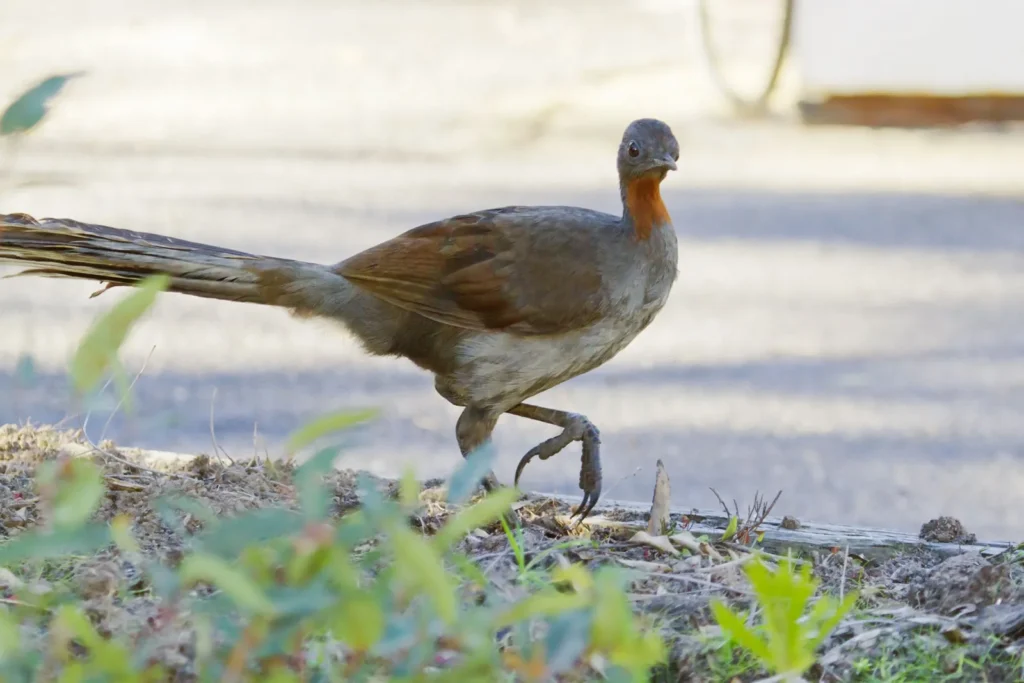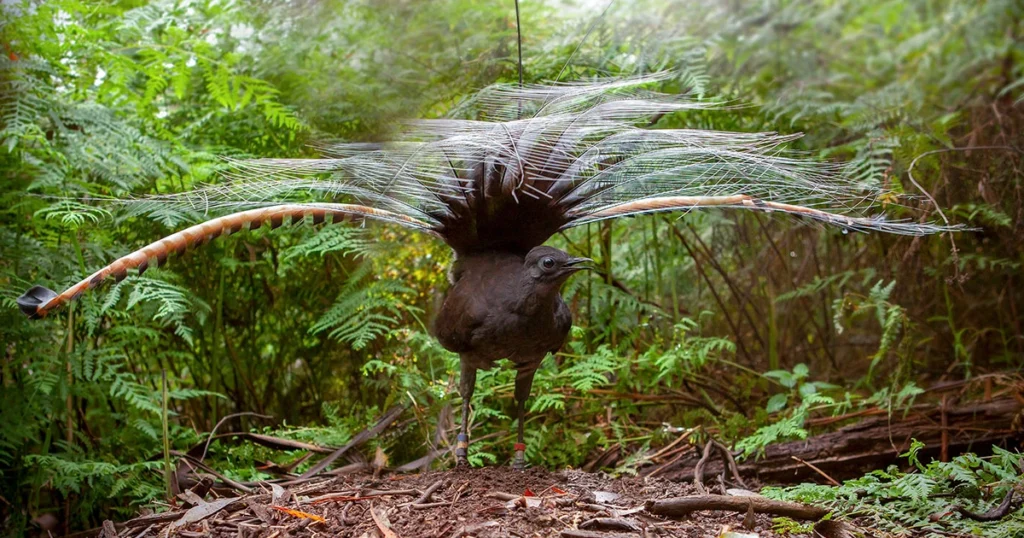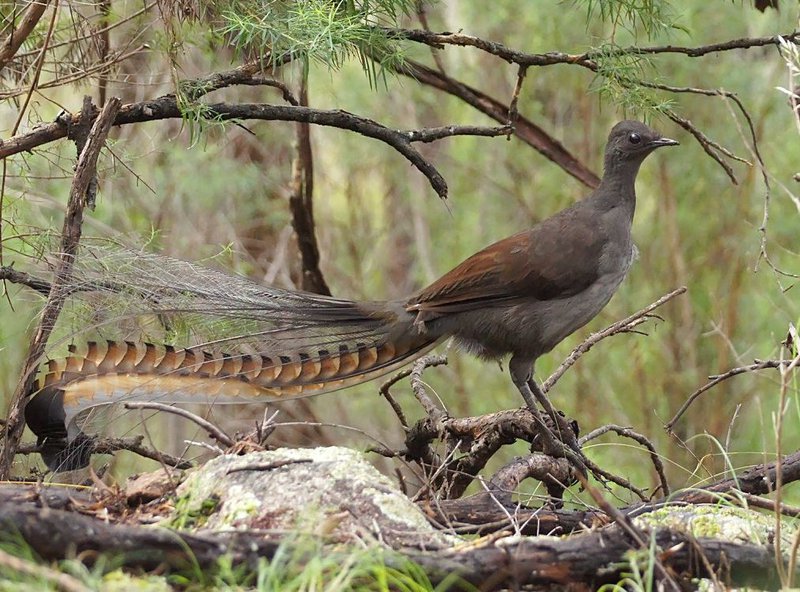Lyrebird (Menura spp.) — Nature’s Ultimate Mimic
Overview & Classification
The lyrebird, a ground-dwelling songbird native to Australia, is one of the most extraordinary vocal mimics in the animal kingdom. There are two known species: the Superb Lyrebird (Menura novaehollandiae) and Albert’s Lyrebird (Menura alberti). These birds are famed not only for their elegant plumage but also for their astonishing ability to imitate both natural and artificial sounds with jaw-dropping precision.
The name “lyrebird” comes from the distinctive lyre-shaped tail feathers of the male Superb Lyrebird, which it uses in dramatic courtship displays. While their tail shape may appear peacock-like at a glance, their courtship rituals, mimicry, and ecological role make them entirely unique among birds.

Master of Mimicry
The lyrebird’s talent for mimicry is nothing short of legendary. These birds can perfectly imitate a wide variety of sounds, including:
- The calls and songs of more than 20 other bird species
- Koala grunts and dingo howls
- Chainsaws, camera shutters, car alarms, mobile phone ringtones
- Human voices and footsteps (when in captivity)
What makes the lyrebird especially intriguing is the accuracy and layering of its mimicry. Males can reproduce several sounds simultaneously, mimicking flocks of birds in distress, or even creating the illusion of a whole forest chorus. In the wild, this mimicry helps attract mates. In captivity or urban-edge habitats, they’ve been observed copying mechanical and human-made noises with eerie precision.
Despite popular videos suggesting that lyrebirds commonly mimic chainsaws and camera clicks, such occurrences are relatively rare in the wild and typically found in birds that have spent time near human activity.

Sound as a Courtship Tool
During the breeding season, male lyrebirds engage in one of the most elaborate courtship displays in the avian world. This includes:
- Constructing display mounds: Small raised platforms of soil and sticks that males clear and maintain
- Performing complex dances: While standing on these mounds, the male fans his tail over his back, forming a shimmering, lyre-like canopy
- Singing long, intricate songs: These performances can last for up to 20 minutes and often consist of a mix of their own vocalizations and perfect imitations of other species
Interestingly, researchers have found that up to 80% of a male’s courtship song can consist of mimicry. This imitation is believed to show off the male’s intelligence, memory, and adaptability—traits that may suggest genetic fitness to females.
Even more fascinating is a behavior in which males mimic alarm calls and wing sounds of multiple species at once. This trick can give the illusion that a predator is nearby, potentially startling the female and stopping her from leaving before mating occurs—a deceptive yet brilliant tactic in the race for reproduction.
Visual Display and Plumage
Though not as brightly colored as some tropical birds, male lyrebirds possess highly ornate tail feathers used in their courtship rituals. The Superb Lyrebird has 16 tail feathers arranged in three layers:
- Two long, curved “lyre” feathers that give the species its name
- Two broad, silver “median” feathers
- Twelve fine, filament-like feathers that add shimmer and movement
Contrary to old depictions, lyrebirds don’t hold their tails high like peacocks. Instead, they bend them forward over their head, forming a sparkling dome during display, which enhances the visual effect while they sing and dance.
Albert’s Lyrebird, the rarer of the two, is found only in small regions of Queensland. It lacks the elaborate lyre-shaped feathers but has a rich chestnut coloration and a similarly powerful voice.
Habitat and Daily Life
Lyrebirds inhabit dense forests and rainforests, primarily in southeastern Australia. These environments offer plenty of leaf litter and soft soil—perfect for their foraging habits. Lyrebirds are ground dwellers that use strong legs and claws to scratch through vegetation in search of:
- Insects and their larvae
- Worms and spiders
- Small reptiles and seeds
Their foraging is not only vital for their diet but also beneficial to the ecosystem. By regularly disturbing the forest floor, they help break down leaf litter, which aids in nutrient cycling, soil aeration, and even reduces fire fuel loads. For this reason, some scientists call lyrebirds “ecosystem engineers.”

Nesting and Reproduction
Female lyrebirds are solely responsible for nesting and raising young. They build dome-shaped nests made from sticks, moss, feathers, and rootlets. These nests are well-hidden—sometimes on the ground, sometimes in low vegetation or tree stumps.
Only one egg is laid per breeding season. The incubation period lasts about six weeks, after which the chick stays in the nest for another 6 to 10 weeks. The young are fed and protected solely by the female, as males play no role in chick-rearing.
Male lyrebirds take years to reach maturity. Their characteristic tail feathers develop only around age 3–4. Until then, young males resemble females and often gather in small groups, staying out of the competitive spotlight until they are ready to perform.
Cultural Learning and Vocal Traditions
Lyrebird song is not entirely instinctual—it is learned. Males pick up vocalizations from their environment and pass them down culturally, much like human language or music. Each geographic population may have its own “song culture,” with slightly different calls and patterns.
This cultural transmission means that some calls have persisted in populations for decades, and in some cases, mimicry has been traced back to sounds that no longer exist in the surrounding environment—a kind of acoustic time capsule.

Conservation Status and Threats
The Superb Lyrebird is currently considered of Least Concern, with a fairly stable population. However, Albert’s Lyrebird is classified as Near Threatened due to its restricted range and small population size.
Both species face several threats:
- Habitat loss and fragmentation due to agriculture, logging, and urban expansion
- Predation by introduced species such as foxes and cats
- Bushfires, particularly the devastating fires of 2019–2020, which destroyed critical habitats
Conservation efforts include habitat protection, predator control, and careful monitoring of population numbers. Educating the public about the ecological importance and cultural fascination of the lyrebird is also key to ensuring its continued survival.
Final Thoughts
The lyrebird is a true marvel of evolution—one that combines vocal mastery, elegant display, and ecosystem stewardship in a single feathered form. Whether it’s mimicking a kookaburra, a chainsaw, or the warning cries of a panicked flock, this bird doesn’t just copy sounds—it transforms them into a performance that speaks volumes about survival, intelligence, and beauty.
In a world where many creatures are vanishing before we fully understand them, the lyrebird stands as a reminder of the wonders still hiding in nature’s chorus. Its story invites us to listen more closely—not just to birdsong, but to the wild world that inspired it.

